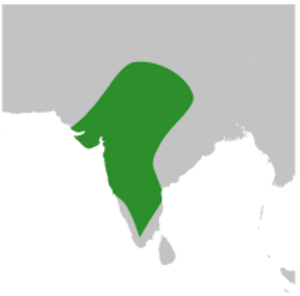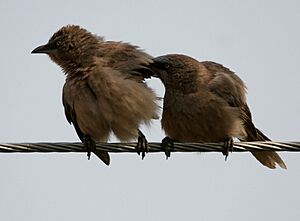Large grey babbler facts for kids
Quick facts for kids Large grey babbler |
|
|---|---|
 |
|
| Conservation status | |
| Scientific classification | |
| Genus: |
Argya
|
| Species: |
malcolmi
|
 |
|
| Synonyms | |
|
|
The Large Gray Babbler (Argya malcolmi) is a type of bird. It belongs to the family Leiothrichidae. You can find these birds all over India and in the western part of Nepal. They are quite common in bushy areas, open forests, and even gardens.
You usually see them in small groups. It's easy to tell them apart from other babblers in their area. They have a special loud, nasal call. Also, their long tails have white feathers on the outside, which you can see clearly. The Large Gray Babbler is one of the biggest babblers in its region.
What They Look Like
This babbler is a large bird with a long tail. Its body is brown. The outer feathers of its tail are a creamy white color. You can easily spot these white feathers when the bird flies low to the ground. They fly with quick, fluttering wing beats.
The area around their eyes (called the lores) is dark. Their forehead is gray with white streaks on the feathers. The lower back and upper tail feathers are a pale gray. The feathers on their back have dark spots. The three outer tail feathers are white. The fourth pair of tail feathers also has white on the outer part. Their wings are a darker brown.
The bird's eyes are yellow. The top part of its beak is dark brown, and the bottom part is yellowish. Their tail has faint lines across it. Sometimes, babblers can have unusual feather colors, like very pale or white feathers.
This bird was first described in the Deccan Plateau region. A person named Colonel W H Sykes gave it its scientific name. He did this to thank Major-General Sir John Malcolm for his help.
Where They Live
You can find the Large Gray Babbler across the Indian subcontinent. This is the large landmass south of the Himalayas. They live east of the Thar desert, reaching as far as Bihar. However, you won't find this bird in Kerala. Also, it's not fully confirmed if they live in the Sind area.
They mostly live in open, dry scrub forests. You can also find them in areas where people grow crops. They are not found in the eastern dry zone of Tamil Nadu. But, one tired bird was once seen in Pondicherry.
Life and Habits

Large Gray Babblers live in small groups. They stay in touch with each other by making loud, nasal calls. All the birds in a group might work together to protect themselves from animals that want to hunt them. Sometimes, a bird might even attack its own reflection!
They are usually seen in open, bushy areas. They look for food on or near the ground. They hop and jump around to find things to eat. Birds in a group might even play together. They mostly eat insects. But they also eat small lizards, snails, and spiders. They also enjoy seeds, grains, and berries.
You can find them in gardens in some cities, like Pune and Ahmedabad. In other cities, like Bangalore, you only see them on the edges of the growing city areas.
These birds are known to lay eggs all year round. But they mostly breed during the rainy season, from March to September. A female usually lays four eggs at a time. Their nest is a shallow cup. They build it in a bush, often a thorny one.
Other birds, like the pied cuckoo and the common hawk-cuckoo, sometimes lay their eggs in the babbler's nest. This is called brood parasitism. It has been suggested that more than one female babbler might lay eggs in the same nest. They might also help each other sit on the eggs. However, this idea has not been fully proven.
Even though there are many Large Gray Babblers, some groups are in danger because people hunt them for food. These birds can sometimes have tiny parasites inside their bodies.


